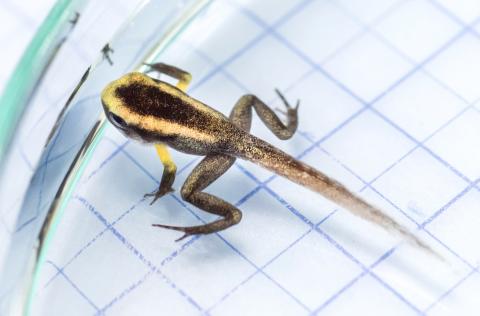Golden poison arrow frogs brought three years ago from Japan’s Maruyama Zoo in Sapporo have produced offspring for the first time, Taipei Zoo officials said on Friday.
It took the mother 12 tries before it could produce offspring, the officials said, adding that the latest batch contained about 20 eggs, and only one has hatched so far.
“When high-quality eggs are laid we see complete membranes and all of the eggs stay together in a cluster. Tadpoles grow into fully developed frogs in about two to three months,” they said.

Photo courtesy of Taipei Zoo
The officials said they are closely watching the tadpole to ensure it develops properly, adding that caretakers have been removing unfertilized eggs from the mother’s tank and changing the water.
The tadpole is mostly black and will gain its telltale golden yellow color after it reaches maturity, they said.
The tadpole will grow to up to 4cm, they said, adding that it is currently about 1cm long.
“People can visit the zoo’s Amphibian and Reptile House to see the frogs’ brilliant colors,” a zoo official said.
“Just like the green and black poison dart frogs and yellow-banded poison dart frogs we received from Maruyama Zoo, golden poison arrow frogs are not afraid of being in the open. Visitors will have plenty of chances to see them,” they added.
The golden poison arrow frog (Phyllobates terribilis), which is endemic to the rainforests along the Pacific coast of Colombia, reaches sexual maturity at about one-and-a-half to two years of age. Ideal breeding conditions for the frog are warm, humid environments and their first batch of eggs usually do not hatch. The rate at which the frog breeds is initially low, but increases over time.

US climber Alex Honnold is to attempt to scale Taipei 101 without a rope and harness in a live Netflix special on Jan. 24, the streaming platform announced on Wednesday. Accounting for the time difference, the two-hour broadcast of Honnold’s climb, called Skyscraper Live, is to air on Jan. 23 in the US, Netflix said in a statement. Honnold, 40, was the first person ever to free solo climb the 900m El Capitan rock formation in Yosemite National Park — a feat that was recorded and later made into the 2018 documentary film Free Solo. Netflix previewed Skyscraper Live in October, after videos

Starting on Jan. 1, YouBike riders must have insurance to use the service, and a six-month trial of NT$5 coupons under certain conditions would be implemented to balance bike shortages, a joint statement from transportation departments across Taipei, New Taipei City and Taoyuan announced yesterday. The rental bike system operator said that coupons would be offered to riders to rent bikes from full stations, for riders who take out an electric-assisted bike from a full station, and for riders who return a bike to an empty station. All riders with YouBike accounts are automatically eligible for the program, and each membership account

A classified Pentagon-produced, multiyear assessment — the Overmatch brief — highlighted unreported Chinese capabilities to destroy US military assets and identified US supply chain choke points, painting a disturbing picture of waning US military might, a New York Times editorial published on Monday said. US Secretary of Defense Pete Hegseth’s comments in November last year that “we lose every time” in Pentagon-conducted war games pitting the US against China further highlighted the uncertainty about the US’ capability to intervene in the event of a Chinese invasion of Taiwan. “It shows the Pentagon’s overreliance on expensive, vulnerable weapons as adversaries field cheap, technologically

NUMBERs IMBALANCE: More than 4 million Taiwanese have visited China this year, while only about half a million Chinese have visited here Beijing has yet to respond to Taiwan’s requests for negotiation over matters related to the recovery of cross-strait tourism, the Tourism Administration said yesterday. Taiwan’s tourism authority issued the statement after Chinese-language daily the China Times reported yesterday that the government’s policy of banning group tours to China does not stop Taiwanese from visiting the country. As of October, more than 4.2 million had traveled to China this year, exceeding last year. Beijing estimated the number of Taiwanese tourists in China could reach 4.5 million this year. By contrast, only 500,000 Chinese tourists are expected in Taiwan, the report said. The report